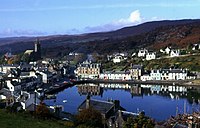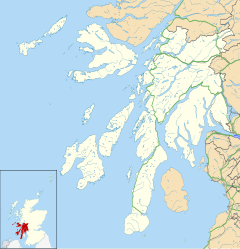Tarbert
| |
|---|---|
 A view over Tarbert Harbour | |
 Church of Scotland parish church, Tarbert | |
Location within Argyll and Bute | |
| Population | 1,120 (2022)[1] |
| OS grid reference | NR 86363 68617 |
| • Edinburgh | 86 mi (138 km) |
| • London | 370 mi (595 km) |
| Council area |
|
| Lieutenancy area |
|
| Country | Scotland |
| Sovereign state | United Kingdom |
| Post town | TARBERT |
| Postcode district | PA29 |
| Dialling code | 01880 |
| UK Parliament |
|
| Scottish Parliament |
|
Tarbert (Scottish Gaelic: An Tairbeart, pronounced [ən̪ˠ ˈt̪ʰaɾʲapərˠʃt̪]; more fully Tairbeart Loch Fìne "Tarbert [of] Loch Fyne" to distinguish it from other Tarberts) is a village in the west of Scotland, in the Argyll and Bute council area. It is built at the head of an inlet of Loch Fyne called East Loch Tarbert, on a narrow isthmus which connects Kintyre to the south with Knapdale to the north and separates East Loch Tarbert from the much longer West Loch Tarbert. Tarbert had a recorded population of 1,338 in the 2001 Census.
Tarbert has a long history both as a harbour and as a strategic point guarding access to Kintyre and the Inner Hebrides. The name Tarbert is the anglicised form of the Gaelic word tairbeart, which literally translates as "carrying across" and refers to the narrowest strip of land between two bodies of water over which goods or entire boats can be carried (portage). In past times cargoes were discharged from vessels berthed in one loch, hauled over the isthmus to the other loch, loaded onto vessels berthed there and shipped onward, allowing seafarers to avoid the sail around the Mull of Kintyre.
Tarbert was anciently part of the Gaelic overkingdom of Dál Riata and protected by three castles – in the village centre, at the head of the West Loch, and on the south side of the East Loch. The ruin of the last of these castles, Tarbert Castle, still exists and dominates Tarbert's skyline. Around the year 1098 Magnus Barefoot, King of Norway, had his longship carried across the isthmus at Tarbert to signify his possession of the Western Isles.
Despite its distinction as a strategic stronghold during the Middle Ages, Tarbert's socioeconomic prosperity came during the Early Modern period, as the port developed into a fishing town. At its height, the Loch Fyne herring fishery attracted hundreds of vessels to Tarbert.

- ^ "Mid-2020 Population Estimates for Settlements and Localities in Scotland". National Records of Scotland. 31 March 2022. Retrieved 31 March 2022.
